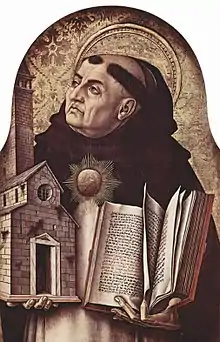Temptation of St. Thomas (Velázquez)
The Temptation of St. Thomas is a painting by the Spanish Baroque painter Diego Velázquez, executed in 1632 and housed in the Museum of Sacred Art of Orihuela Cathedral, southern Spain.
| Temptation of St. Thomas | |
|---|---|
 | |
| Artist | Diego Velázquez |
| Year | 1632 |
| Medium | Oil on canvas |
| Dimensions | 244 cm × 203 cm (96 in × 80 in) |
| Location | Cathedral Museum of Sacred Art, Orihuela |
The work, for a period, was attributed to Murcian painter Nicolás de Villacis, until it was recognized as Velázquez's in the 1920s. It portrays the episode of the life of Saint Thomas Aquinas when, as a novice, he resisted the temptation represented by a prostitute, who is visible in the background door. The saint is held by an angel, while another is preparing to dress him with a white ribbon, representing chastity.
Temptation of St. Thomas is among Velázquez's better-known paintings.[1]
References
- Lowe, Alfonso; Seymour-Davies, Hugh (2000). The Companion Guide to the South of Spain. Companion Guides. p. 345. ISBN 1900639335.
Sources
- __ (1990). Velázquez, Catálogo de la Exposición. Museo del Prado.CS1 maint: numeric names: authors list (link)
External links
- Velázquez , exhibition catalog from The Metropolitan Museum of Art (fully available online as PDF), which contains material on this painting (see index)
This article is issued from Wikipedia. The text is licensed under Creative Commons - Attribution - Sharealike. Additional terms may apply for the media files.
